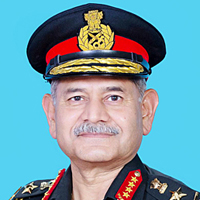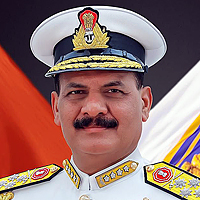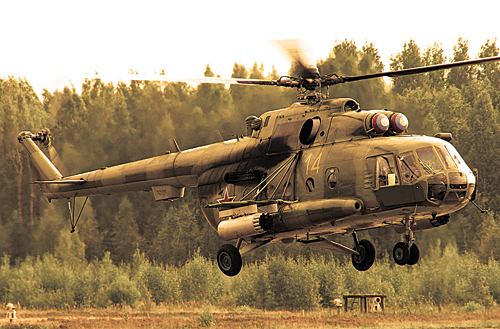INDIAN ARMED FORCES CHIEFS ON OUR RELENTLESS AND FOCUSED PUBLISHING EFFORTS

The insightful articles, inspiring narrations and analytical perspectives presented by the Editorial Team, establish an alluring connect with the reader. My compliments and best wishes to SP Guide Publications.

"Over the past 60 years, the growth of SP Guide Publications has mirrored the rising stature of Indian Navy. Its well-researched and informative magazines on Defence and Aerospace sector have served to shape an educated opinion of our military personnel, policy makers and the public alike. I wish SP's Publication team continued success, fair winds and following seas in all future endeavour!"

Since, its inception in 1964, SP Guide Publications has consistently demonstrated commitment to high-quality journalism in the aerospace and defence sectors, earning a well-deserved reputation as Asia's largest media house in this domain. I wish SP Guide Publications continued success in its pursuit of excellence.
Mil Mi-8: The Most Produced Helicopter in History
When the Mi-8 was first displayed at the 1965 Paris Air Show, it created a sensation. Western analysts had long considered Soviet technology inferior to that of the West, but the comments about the Mi-8 were mainly positive.

The Mil Mi-8 is a versatile, medium-lift, twin-turbine helicopter, in widespread use in both military and civilian roles, particularly as a transport helicopter. It holds the distinction of being the most produced helicopter ever. The design of this iconic machine was drawn up in the 1950s by the Mil Design Bureau, headed by Mikhail Mil. Mil believed that gas turbine engines would revolutionise helicopter construction and make a breakthrough both in flight performance and economic efficiency. During over six decades of production, perhaps 17,000 Mi-8s have been delivered to around 80 countries worldwide. ‘Eights’, as they are colloquially called, are still being built, and continue in service all over the world. Both Russia and Ukraine utilise them in their ongoing conflict.
The Mi-8 story began with Soviet Prime Minister Nikita Khrushchev who, on a visit to the USA in September 1959, was taken on a trip aboard the US presidential helicopter. This was the age of intense superpower rivalry, when the refrain was, “Anything you can do, I can do better!” Khrushchev wanted something to impress the US president on his reciprocal visit to the Soviet Union. In the meantime, the Soviet military, was also planning a new and better machine to replace the existing Mi-4. Consequently, a team of developers soon got to work on the proposed helicopter.
The Mi-8 took off for the first time on June 24, 1961. It was the civilian sector that first began to exploit the new machine. It was only when the Bell UH-1helicopter proved a great asset to the United States during the Vietnam War that the Soviet military rushed a troop-carrying variant of the Mi-8 into production. By 1967, the first military variant entered service with the Soviet Air Force.
When the Mi-8 was first displayed at the 1965 Paris Air Show, it created a sensation. Western analysts had long considered Soviet technology inferior to that of the West, but the comments about the Mi-8 were mainly positive. Indeed, the Mi-8 was a well-designed aircraft with outstanding flight performance and the ability to fly in extreme weather conditions. It had good ergonomics for both crew and passengers and a spacious and comfortable cargo compartment. And its five blade main rotor reduced noise and vibration significantly.
A worldwide sales tour for the aircraft followed and it netted a number of overseas orders. With demand surging, another series production facility was set up in Ulan-Ude in 1970. In the 1970s the Mi-8 was fitted with more powerful twin Klimov TV3-117MT turboshaft engines of 1,454 kW (1,950 hp) each. With these engines, it has a max speed of 250 km/h, range of 495 km, and service ceiling of 5,000 m. Its payload capacity is 24 passengers, or up to 4,000 kg of cargo, or weaponry on up to six hard points. Latest models can carry up to 5,000 kg. It has a crew of three: a pilot, co-pilot/navigator and a flight engineer.
If there is a job that needs a helicopter, the Mi-8 can probably do it. Not for nothing is it called the ‘hundred professions’ helicopter since it has appeared in over a hundred variants and derivatives. Its roles include personnel and armament transportation, search and rescue, medevac, fire support, suppression of adversary firing positions, mine laying, aerial refuelling, and electronic warfare. There is even an amphibious variant for naval use. A dedicated export variant, the Mi-17, was produced from the 1980s onwards. It was basically a Mi-8 with more power and a new tail rotor.
The Mi-8 arrived in India in 1971 and was inducted in 1972. The IAF procured a total of 107 Mi-8s between 1971 and 1988. Between 2008 and 2013, 151 Mi-17 helicopters were also purchased, primarily for operations in the mountains. Mi-8s and Mi-17s have proved invaluable in major IAF operations like Operation Meghdoot and Operation Pawan as well as humanitarian and disaster relief missions. They are also employed in the VIP/VVIP transport role as well as the training role. The Mi-8 was formally phased out of the IAF inventory by December 2017. However, the IAF still operates three variants of the Mi-17, including the latest Mi-17V5, which form the backbone of its medium-lift helicopter fleet.
One of the strengths of the Mi-8 is that its design has continually evolved to keep pace with changing times and new requirements. Take the Mi-8MTV-5-1 that has been in service with the Russian military since 2011. One of its main features is that it can fly and navigate even in the complete absence of light. The IAF’s Mi-17V-5 helicopter too is equipped with night vision technology, on-board weather radar, a new PKV-8 autopilot system, and a KNEI-8 avionics suite, which has a clear and intuitive cockpit, with four large multi-functional displays that are easy to read and help reduce pilot fatigue.





